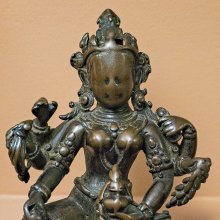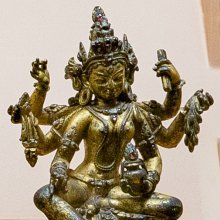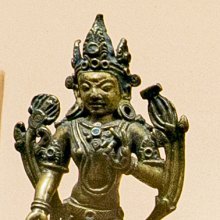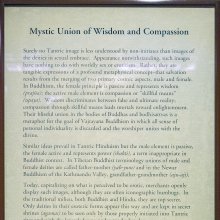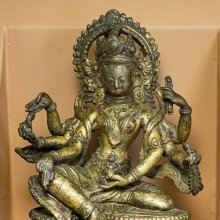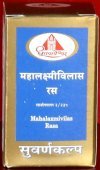Knowledge: 5 definitions
Introduction:
Knowledge means something in Hinduism, Sanskrit. If you want to know the exact meaning, history, etymology or English translation of this term then check out the descriptions on this page. Add your comment or reference to a book if you want to contribute to this summary article.
Images (photo gallery)
(+10 more images available)
In Hinduism
Ayurveda (science of life)
Source: INSA Digital Repository: Caraka’s Approach to KnowledgeKnowledge of life (Ayurveda) deals with the characteristics of life endowed by nature, which are eternal (Cf. Charaka Samhita verse 30.27).—Caraka recognised three primary urges in human life—the urge to live long, to earn a living and to secure a good afterlife (Charaka Samhita verse 11.3-6). About afterlife, he noted that there were doubts because it was not perceptible through our senses. This was the context in which he introduced the subject of accessing exact knowledge.
Charaka recognised at least four means of Knowledge:
- Knowledge gained through Testimony of Sages (Sanskrit: āptopadeśa),
- Knowledge gained through Perception (Sanskrit: pratyakṣa),
- Knowledge gained through Inference (Sanskrit: anumāna),
- Knowledge gained through Reason (Sanskrit: yukti).

Āyurveda (आयुर्वेद, ayurveda) is a branch of Indian science dealing with medicine, herbalism, taxology, anatomy, surgery, alchemy and related topics. Traditional practice of Āyurveda in ancient India dates back to at least the first millenium BC. Literature is commonly written in Sanskrit using various poetic metres.
Purana and Itihasa (epic history)
Source: Shodhganga: Elements of Art and Architecture in the Trtiyakhanda of the VisnudharmottarapuranaKnowledge (of various subjects) refers to several of the “sixty four kinds of Art”, according to the Kamasutra of Vatsyayana.—Cf. the Sanskrit Nāṭakākhyāyikādarśana.—Indian tradition, basically includes sixty four Art forms are acknowledged. The history of Indian Art covers approximately five thousand years which presents a rich and almost continuous record. The references of sixty four kinds of Kala (कला, kalā) are found in the Bhagavatapurana, Shaiva-Tantras, Kamasutra of Vatsyayana etc.
Knowledge of the following subjects were commonly counted among the list of Arts:
- Knowledge of dramas and stories.
- Knowledge about precious metals and stones.
- Knowledge of metals.
- Knowledge of jewel, colours and mines.
- Knowledge of foreign languages.
- Knowledge of etymology.
- Knowledge of lexicography.
- Knowledge of proper behavior or the training of domestic animals.
- Knowledge of science of victory.

The Purana (पुराण, purāṇas) refers to Sanskrit literature preserving ancient India’s vast cultural history, including historical legends, religious ceremonies, various arts and sciences. The eighteen mahapuranas total over 400,000 shlokas (metrical couplets) and date to at least several centuries BCE.
Yoga (school of philosophy)
Source: ORA: Amanaska (king of all yogas): A Critical Edition and Annotated Translation by Jason BirchKnowledge (of the Tattvas or Mudrās) can be denoted by the Sanskrit terms Jñāna or Parijñāna, according to the Śivayogadīpikā by Sadāśivayogīśvara: a text dealing with Śaivism and Haṭhayoga in two hundred and eighty-nine verses.—Accordingly, “Knowledge (jñāna) of the twenty-five Tattvas is that [Rājayoga] which is called Sāṅkhya. The [Rāja]yoga called Tāraka is [so called] because [it consists in] knowledge (parijñāna) of external Mudrā, and Amanaska is [so called] because [it consists in] knowledge (parijñāna) of internal Mudrā. Tāraka is more laudable than Sāṅkhya and Amanaska is more laudable than Tāraka. Because it is the king of all Yogas, it is called Rājayoga”.

Yoga is originally considered a branch of Hindu philosophy (astika), but both ancient and modern Yoga combine the physical, mental and spiritual. Yoga teaches various physical techniques also known as āsanas (postures), used for various purposes (eg., meditation, contemplation, relaxation).
Pancaratra (worship of Nārāyaṇa)
Source: archive.org: Catalogue of Pancaratra Agama Texts1) Knowledge (which should be cultivated) is of six kinds, as discussed in chapter 33 of the Paushkara-Samhita: a Pancaratra text of almost 5900 verses divided into forty-three chapters presented as a frame-work dialogue between Paushkara and Bhagavan dealing with the esoteric meaning of mandala-designs, worship routines and temple-building.—Description of the chapter [tattva-samākhyāna]: [...] As for mastery of the tattvas [tattvajaya], this comes only by mastery over life by means of practical yoga which is aimed at the acquisition of jñāna-wisdom (87-130). To this end, certain kinds of knowledge and behavior should be cultivated, other kinds should be eschewed.
The kinds of knowledge to be acquired are six:
- adhibhūta,
- adhyātma,
- adhidaivata,
- pralaya,
- sṛṣṭi and
- aiśvarya (145-146)
And in a grasp of these is all knowledge comprehended (131-174a).
2) Those seeking “Knowledge” are advised to worship icons of Rudra, as discussed in the twenty-eighth chapter of the Naradiya-Samhita: a Pancaratra document comprising over 3000 verses in 30 chapters presenting in a narrative framework the teachings of Narada to Gautama, dealing primarily with modes of worship and festivals.—Description of the chapter [sarvadevatā-sthāpanavidhi]: Nārada describes the worship appropriate to each god for specified ends: [e.g., Rudra for knowledge (52-58)] [...]. In discussing next the shrine dedicated to each, he describes their shapes, proportions, the building materials used, the types and postures of the icons contained therein, [...].

Pancaratra (पाञ्चरात्र, pāñcarātra) represents a tradition of Hinduism where Narayana is revered and worshipped. Closeley related to Vaishnavism, the Pancaratra literature includes various Agamas and tantras incorporating many Vaishnava philosophies.
Jyotisha (astronomy and astrology)
Source: Journal of South Asian Intellectual History: Samarasiṃha and the Early Transmission of Tājika AstrologyKnowledge refers to one the “thirty-two astrological lots” (sahamas), as discussed in the fourth chapter of the Karmaprakāśa—one of the earliest preserved Sanskrit works on Perso-Arabic (Tājika) astrology authored by Samarasiṃha in the 13th century.—The so-called lots (Sanskrit: sahamas; Arabic: sahm, translating κλῆρος) are derived by measuring the longitudinal distance between two predefined points in a horoscope (typically two planets) and projecting it from a third point (typically the ascendant degree). Of these 32 lots [e.g., Knowledge], all but two are present in what has become the most widespread list of Tājika sahamas, compiled some three centuries later by Nīlakaṇṭha and comprising 50 items.

Jyotisha (ज्योतिष, jyotiṣa or jyotish) refers to ‘astronomy’ or “Vedic astrology” and represents the fifth of the six Vedangas (additional sciences to be studied along with the Vedas). Jyotisha concerns itself with the study and prediction of the movements of celestial bodies, in order to calculate the auspicious time for rituals and ceremonies.
See also (Relevant definitions)
Partial matches: Knowledge, Te.
Starts with: Knowledge obstacle, Knowledge of everything.
Query error!
Full-text (+9958): Jnana, Vidya, Pramana, Veda, Vijnana, Atmajnana, Tattvajnana, Parijnana, Jnanin, Bodha, Brahmajnana, Pratyaksha, Atmabodha, Dharmajnana, Pramiti, Atmavidya, Avidya, Jnanamaya, Anumana, Brahmavidya.
Relevant text
Search found 607 books and stories containing Knowledge, The knowledge; (plurals include: Knowledges, The knowledges). You can also click to the full overview containing English textual excerpts. Below are direct links for the most relevant articles:
Maha Prajnaparamita Sastra (by Gelongma Karma Migme Chödrön)
I. Knowledge of the Śrāvakas < [Part 3 - Outshining the knowledge of all the Śrāvakas and Pratyekabuddhas]
1. Prajñā of the śrāvakas < [Part 2 - Prajñā and the prajñās]
V. Why the Buddha eliminates the traces < [VIII. Destroying the traces of the conflicting emotions]
Abhidharmakośa (by Leo M. Pruden)
The Buddhist Path to Enlightenment (study) (by Dr Kala Acharya)
4.2.5. Faculty of Wisdom (Paññindriya or Prajñā) < [Chapter 2 - Five Groups of Factor]
6.8. How to Attain Nibbāna < [Chapter 4 - Comparative Study of Liberation in Jainism and Buddhism]
6.2. Nibbāna in Pāli Commentarial Texts < [Chapter 4 - Comparative Study of Liberation in Jainism and Buddhism]
Jataka tales [English], Volume 1-6 (by Robert Chalmers)
Jataka 144: Naṅguṭṭha-jātaka < [Book I - Ekanipāta]
Jataka 106: Udañcani-jātaka < [Book I - Ekanipāta]
Jataka 87: Maṃgala-jātaka < [Book I - Ekanipāta]
Gitartha Samgraha (critical Study) (by Partha Sarathi Sil)
1. History of Kashmir Śaivism < [Chapter 3 - A Brief Sketch of Kashmir Śaivism]
5. Jñānaṣaṭka in the Gītārthasaṅgraha < [Chapter 4 - Critical Study of the Gītārthasaṅgraha]
2. Concept of Ṣaṭka in the Gītārthasaṅgraha < [Chapter 4 - Critical Study of the Gītārthasaṅgraha]
Visuddhimagga (the pah of purification) (by Ñāṇamoli Bhikkhu)
Introduction (the eight knowledges) < [Chapter XXI - Purification by Knowledge and Vision of the Way]
Insight (4): Knowledge of Danger < [Chapter XXI - Purification by Knowledge and Vision of the Way]
General (conclusion to the direct-knowledges) < [Chapter XIII - Other Direct-knowledges (abhiññā-niddesa)]
Related products
(+65 more products available)

